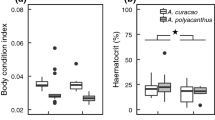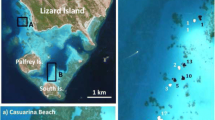Abstract
On coral reef systems, ‘client’ fishes combat relentless ectoparasitic infections by engaging in frequent mutualistic interactions with various ‘cleaner’ organisms. Clients are known to adjust their visits to cleaners according to their ectoparasite load. Whether physiological changes due to the ectoparasitic infection, prior to engaging in cleaning interactions, might inform clients of their current need to visit cleaners remains unclear. Here, we tested whether fish blood parameters vary with ectoparasitic infection: we exposed clients (Scolopsis bilineatus) to hematophagous ectoparasite gnathiid isopods (Gnathia aureamaculosa) or a control situation for 30 min, then collected fish blood and counted gnathiids attached to fish. We found that gnathiid-exposed fish had higher blood cortisol hormone levels compared with controls. This suggests gnathiid presence in the experimental situation results in an acute stress hormone response in a fish. In contrast, while hematocrit level, a correlate of blood loss, did not significantly differ between treatments, within gnathiid-exposed fish hematocrit was negatively related to attached gnathiid number. This suggests hematocrit could provide information to a fish about gnathiid load. Thus, short-term exposure to an ectoparasite translates into possible proximate physiological mechanisms underlying client’s decisions involving interactions with cleaners.



Similar content being viewed by others
References
Boots M, Sasaki A (2002) Parasite-driven extinction in spatially explicit host-parasite systems. Am Nat 159:706–713
Bshary R, Grutter AS (2002) Experimental evidence that partner choice is a driving force in the payoff distribution among cooperators or mutualists: the cleaner fish case. Ecol Lett 5:130–136
Cheney KL, Côté IM (2001) Are Caribbean cleaning symbioses mutualistic? Costs and benefits of visiting cleaning stations to longfin damselfish. Anim Behav 62:927–933. doi:10.1006/anbe.2001.1832
Clague GE, Cheney KL, Goldizen AW et al (2011) Long-term cleaner fish presence affects growth of a coral reef fish. Biol Lett 7:863–865. doi:10.1098/rsbl.2011.0458
Côté IM (2000) Evolution and ecology of cleaning symbioses in the sea. Oceanogr Mar Biol 38:311–355
Dunlap KD, Mathies T (1993) Effects of nymphal ticks and their interaction with malaria on the physiology of male fence lizards. Copeia 1993:1045. doi:10.2307/1447082
Ebert D, Lipsitch M, Mangin KL (2000) The effect of parasites on host population density and extinction: experimental epidemiology with Daphnia and six microparasites. Am Nat 156:459–477. doi:10.1086/303404
Galhardo L, Oliveira RF (2009) Psychological stress and welfare in fish. Annu Rev Biomed Sci 11:1–20
Grutter AS (1994) Spatial and temporal variations of the ectoparasites of seven reef fish species from Lizard Island and Heron Island, Australia. Mar Ecol Prog Ser 115:21–30
Grutter AS (1995) Relationship between cleaning rates and ectoparasite loads in coral reef fishes. Mar Ecol Prog Ser 118:51–58
Grutter AS (1996) Parasite removal rates by the cleaner wrasse Labroides dimidiatus. Mar Ecol Prog Ser 130:61–70
Grutter AS (1999) Infestation dynamics of gnathiid isopod juveniles parasitic on the coral-reef fish Hemigymnus melapterus (Labridae). Mar Biol 135:545–552. doi:10.1007/s002270050655
Grutter AS (2001) Parasite infection rather than tactile stimulation is the proximate cause of cleaning behaviour in reef fish. Proc R Soc B Biol Sci 268:1361–1365. doi:10.1098/rspb.2001.1658
Grutter AS (2003) Feeding ecology of the fish ectoparasite Gnathia sp. (Crustacea: Isopoda) from the Great Barrier Reef, and its implications for fish cleaning behaviour. Mar Ecol Prog Ser 259:295–302
Grutter AS, Bshary R (2003) Cleaner wrasse prefer client mucus: support for partner control mechanisms in cleaning interactions. Proc R Soc Lond B Biol Sci 270:S242–S244
Grutter A, Pankhurst NW (2000) The effects of capture, handling, confinement and ectoparasite load on plasma levels of cortisol, glucose and lactate in the coral reef fish Hemigymnus melapterus. J Fish Biol 57:391–401. doi:10.1006/jfbi.2000.1312
Hart BL (1990) Behavioral adaptations to pathogens and parasites: five strategies. Neurosci Biobehav Rev 14:273–294. doi:10.1016/S0149-7634(05)80038-7
Houston AH, Murad A (1995) Erythrodynamics in fish: recovery of the goldfish Carassius auratus from acute anemia. Can J Zool 73:411–418. doi:10.1139/z95-046
Jones CM, Grutter AS (2005) Parasitic isopods (Gnathia sp.) reduce haematocrit in captive blackeye thicklip (Labridae) on the Great Barrier Reef. J Fish Biol 66:860–864
Marino F, Giannetto S, Paradiso M et al (2004) Tissue damage and haematophagia due to praniza larvae (Isopoda: Gnathiidae) in some aquarium seawater teleosts. Dis Aquat Organ 59:43–47. doi:10.3354/dao059043
Ogawa K, Inouye K (1997) Heterobothrium infection of cultured tiger puffer, Takifugu rubripes—a field observation. Fish Pathol 32:15–20. doi:10.3147/jsfp.32.15
Pankhurst NW (2011) The endocrinology of stress in fish: an environmental perspective. Gen Comp Endocrinol 170:265–275. doi:10.1016/j.ygcen.2010.07.017
Quillfeldt P, Masello JF, Möstl E (2004) Blood chemistry in relation to nutrition and ectoparasite load in Wilson’s storm-petrels Oceanites oceanicus. Polar Biol 27:168–176. doi:10.1007/s00300-003-0572-2
Rechav Y, Kuhn HG, Knight MM (1980) The effects of the tick Amblyomma hebraeum (Acari: Ixodidae) on blood composition and weight of rabbits. J Med Entomol 17:555–560. doi:10.1093/jmedent/17.6.555
Ros AFH, Lusa J, Meyer M et al (2011) Does access to the bluestreak cleaner wrasse Labroides dimidiatus affect indicators of stress and health in resident reef fishes in the Red Sea? Horm Behav 59:151–158. doi:10.1016/j.yhbeh.2010.11.006
Ros AFH, Vullioud P, Bshary R (2012) Treatment with the glucocorticoid antagonist RU486 reduces cooperative cleaning visits of a common reef fish, the lined bristletooth. Horm Behav 61:37–43. doi:10.1016/j.yhbeh.2011.09.013
Small M, Lowe GDO, Cameron E, Forbes CD (1983) Contribution of the haematocrit to the bleeding time. Pathophysiol Haemost Thromb 13:379–384. doi:10.1159/000214826
Smit NJ, Davies AJ (2004) The curious life-style of the parasitic stages of gnathiid isopods. In: Advances in parasitology, vol 58. Academic Press, Elsevier, pp 289–391. doi:10.1016/S0065-308X(04)58005-3
Soares MC, Bshary R, Cardoso SC, Côté IM (2008) The meaning of jolts by fish clients of cleaning gobies. Ethology 114:209–214. doi:10.1111/j.1439-0310.2007.01471.x
St. Juliana JR, Khokhlova IS, Wielebnowski N et al (2014) Ectoparasitism and stress hormones: strategy of host exploitation, common host–parasite history and energetics matter. J Anim Ecol 83:1113–1123. doi:10.1111/1365-2656.12217
Sures B (2006) How parasitism and pollution affect the physiological homeostasis of aquatic hosts. J Helminthol 80:151–157. doi:10.1079/JOH2006346
Szabó K, Szalmás A, Liker A, Barta Z (2002) Effects of haematophagous mites on nestling house sparrows (Passer domesticus). Acta Parasitol 47:318–322
Wagner ELES, Roche DG, Binning SA et al (2015) Temporal comparison and predictors of fish species abundance and richness on undisturbed coral reef patches. PeerJ 3:e1459. doi:10.7717/peerj.1459
Woo PTK (1979) Trypanoplasma salmositica: experimental infections in rainbow trout, Salmo gairdneri. Exp Parasitol 47:36–48. doi:10.1016/0014-4894(79)90005-5
Zamzow JP, Losey GS (2002) Ultraviolet radiation absorbance by coral reef fish mucus: photo-protection and visual communication. Environ Biol Fishes 63:41–47
Acknowledgments
We thank the LIRS directors and staff for their support and friendship. We also thank D. Nusbaumer, S. Gingins, and D. Sun for their assistance, and G. Glauser and A. Vallat from the Chemical Analytical Service of the University of Neuchâtel for their assistance with MS-HPLC analysis.
Funding
This study was funded by the Australian Research Council (ASG and RB), the Swiss Science Foundation (RB), and the Swiss Scholarships for foreign students (ZT).
Author information
Authors and Affiliations
Corresponding author
Ethics declarations
Conflict of interest
All authors declare that they have no conflict of interest.
Ethical standards
The University of Queensland Animal Ethics Committee approved the project.
Additional information
Resposible Editor: K. D. Clements.
Reviewed by B. Nowak and an undisclosed expert.
Electronic supplementary material
Below is the link to the electronic supplementary material.
Rights and permissions
About this article
Cite this article
Triki, Z., Grutter, A.S., Bshary, R. et al. Effects of short-term exposure to ectoparasites on fish cortisol and hematocrit levels. Mar Biol 163, 187 (2016). https://doi.org/10.1007/s00227-016-2959-y
Received:
Accepted:
Published:
DOI: https://doi.org/10.1007/s00227-016-2959-y




